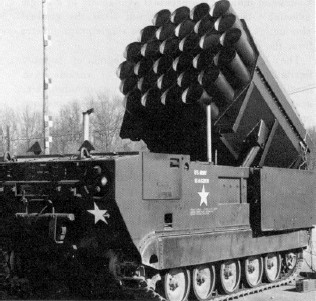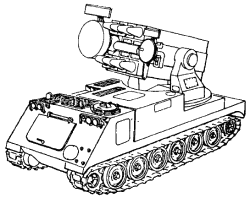M113 vehicles are either thick skinned (armored) or thin skinned (unarmored). The armored variants are derived
from the M113/A1/A2/A3, and the unarmored variants are derived from the M548.
The M667 guided missile carrier is a special exception. It is thin skinned, but is not based on the M548.
- T113, T113E1, T113E2, T117
-
Developed as a replacement for the M59 tracked carrier. The carriers differed primarily in the amount and type of armor protection.
The T113-series vehicles featured an aluminum chassis and aluminum armor. Developed by Ordnance Tank-Automotive Command (OTAC) and manufactured by the Food Machinery & Chemical Corporation (FMC).
The T113E2 was the basis for the production M113.
- M113 Full Tracked Armored Personnel Carrier (NSN 2350-00-629-1294)
-
1960. Original production model. Gasoline-powered. See data above. Almost all M113 vehicles in U.S. service have been converted to the A2 or A3 variant.
- M113 ACAV
-
Armored cavalry assault vehicle. Vietnam War-era modifications of the M113 with additional machine guns and armor shields. Used as an assault vehicle or light tank.
Typically had a crew of four: the track commander, driver, two M60 machine gunners, and an M79 grenadier.
FMC manufactured an "A" kit armament sub-system for the M113 which consisted of:
- Hatch armor and gun shield for the commander's .50 caliber M2HB heavy machine gun.
- Two 7.62mm M60 light machine guns.
- Two elbow pintle mounts with gun shields for mounting the M6O LMGs to the left and right of the cargo hatch.
- A removeable pintle mount on the rear of the M113 in which either of the M60 LMGs with shield could be mounted.
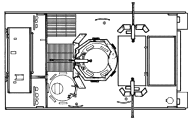
M113 ACAV, top view
600x380, 39K, GIF
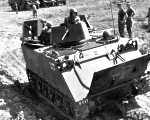
M113 ACAV, Vietnam
U.S. DoD Photo
800x630, 149K, B/W, JPEG
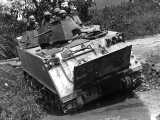
M113 ACAV, Vietnam
U.S. DoD Photo
1393x1122, 266K, B/W, JPEG
- M113A1 Full Tracked Armored Personnel Carrier (NSN 2350-00-968-6321)
-
1964. "Carrier, Personnel, Full Tracked, Armored, M113A1." Replaced the gasoline-powered engine with a diesel engine. See data above.
Almost all M113A1 vehicles have been converted to the A2 or A3 variant.
Armors available include Rafael Enhanced Add-on Armor Kit (EAAK), Creusot-Marrel plate armor, and SNPE explosive reactive armor.
Thermal and TV sights are also available.
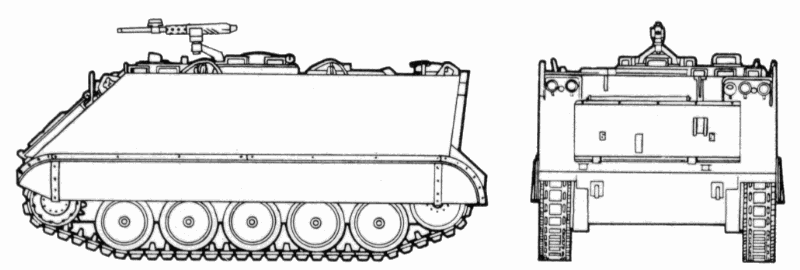
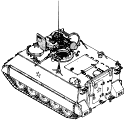
M113/M113A1 with M47 Dragon missile in M175 mount
625x600, 35K, GIF
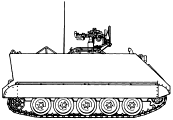
M113/M113A1 with M175 mount
635x440, 17K, GIF
- M113A1 TOW Guided Missile Equipment Carrier (FSN 1450-176-2697)
-
1971. Also known as the "M220 TOW Vehicle."
This variant consisted of an M113A1 APC with an M233 TOW mounting kit installed. The kit provided for stowage of a
TOW launcher, 10 missiles, and the four-man TOW crew inside the vehicle. A ground tripod was also carried to allow
dismounted operation of the TOW launcher.
The M233 kit consisted of a pedestal unit mounted on double vertical rails which were pivoted at the vehicle
floor under the troop compartment roof hatch. The pedestal unit was raised on the rails and the launch tube
was attached and loaded for firing. The vehicle was capable of limited cross country travel
while the launcher was in the raised position.
Initial production tests were completed in July 1970, and the mounting kit was reclassified from
"Limited Production" (XM-233E1) to "Standard A" (M233) on August 20, 1971.
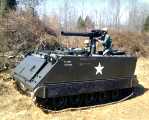
M113A1 with M233 TOW kit
U.S. Army Photo
720x576, 82K, JPEG
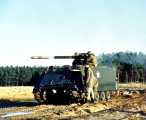
M113A1 firing TOW missile
U.S. Army Photo
720x576, 50K, JPEG
- M113A1 TOW CAP
-
1977. The M113A1 TOW carrier provided no protection for the gunner or launcher when in firing position.
The TOW CAP (Cover, Artillery Protection) was developed to provide protection against shrapnel and small arms fire.
The system consisted of four ballistic nylon panels hooked together and manually raised over a tubular steel frame.
There was also a front panel below the TOW launcher which provided some frontal protection.
When not in use, the cover was folded into two storage sections on the deck of the carrier.
The CAP system could be removed from the carrier and used with the TOW launcher for dismounted operations.
The TOW CAP was an interim system used while the M901 Improved TOW Vehicle was being developed.
- M113A2 Full Tracked Armored Personnel Carrier (NSN 2350-01-068-4077)
-
1979. "Carrier, Personnel, Full Tracked, Armored, M113A2."
The A2 variant introduced suspension and cooling enhancements. See data above.
This carrier can be used for cargo, ambulance, or reconnaissance work.
Many M113A2 vehicles have been converted to the A3 variant.
Capabilities and features include:
- Travels easily over rough terrain.
- Fords water up to 40 inches deep.
- Can move at high speeds on improved roads and highways.
- Air transportable and can be dropped by parachute to troops in the field.
- Propelled and steered on land and in water by tracks.
- Has M17 periscopes around the driver's and commander's hatches for vision when buttoned up.
- Has an M19 infrared periscope stowed near the driver. The periscope can be installed in the driver's hatch to provide night vision under blackout conditions.
- Equipped with smoke grenade launchers.
- Equipped to carry a NBC (gas particulate filter) unit, driver's windshield kit, engine coolant heater kit, and personnel heater kit (for cold weather operation).
- Can be equipped to carry a hospital litter kit, marine recovery kit, capstan kit, Dragon missile system, and night observation device system.
- Some later models of A2 configuration include armored external fuel tanks.
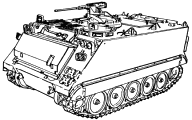
M113A2
720x415, 36K, GIF

M113A2 camo pattern
650x815, 69K, GIF
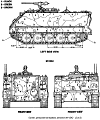
M113A2 camo pattern
650x775, 61K, GIF
- M113A3 Full Tracked Armored Personnel Carrier (NSN 2350-01-219-7577)
-
1987. The M113A3 is a product improved version of the M113A2. The upgrade enhances
engine power and crew survivability. See data above.
This carrier can be used for cargo, ambulance, or reconnaissance work.
Type classified Standard in the U.S. All new APC vehicles produced since 1987 and all converted vehicles since
1989 are the A3 variant. U.S. production of new M113A3s was completed in 1992. As of Fiscal Year 2007, the average
cost of each A2 to A3 conversion is approximately $160,000.
Capabilities and features include:
- Travels easily over rough terrain.
- Fords water up to 40 inches deep.
- Can move at high speeds on improved roads and highways.
- Air transportable and can be dropped by parachute to troops in the fields.
- Propelled and steered on land and in water by tracks.
- Has M17 periscopes around the driver's and commander's hatches for vision when buttoned up.
- Has an AN/VVS periscope stowed near the driver. The periscope can be installed in the driver's hatch to provide night vision under blackout conditions.
- Equipped with smoke grenade launchers.
- Equipped with an M8A3 NBC system (with heaters).
- Equipped to carry driver's windshield kit, engine coolant heater kit, and personnel heater kit (for cold weather operation).
- Can be equipped to carry a hospital litter kit, tow pintle extender kit, and water/ration heater kit.
External differences between M113A2 and M113A3:
- External armored fuel tanks located on each side of rear ramp. Independent valving allows continued operation when one tank is damaged.
Moving the fuel tanks outside the hull reduces the fire hazard inside the crew compartment.
Note that some later models of A2 configuration include armored external fuel tanks.
- Provisions for the installation of a bolt-on armor kit.
The bolt-on armor kit (which increases the gross vehicle weight to 31,000 pounds) was developed and tested but not incorporated for production.
Internal differences between M113A2 and M113A3 include:
- Improved X200-4A transmission and 275 horsepower turbocharged engine: the "RISE" (Reliability Improvements for Selected Equipment) powertrain.
This power train upgrade replaces less reliable components reducing operations and support costs while increasing mobility to keep up with the M1 Abrams and Bradley Fighting Vehicle System fleet.
- Improved driver controls: an automotive-type steering yoke and foot brake arrangement, power brakes.
- Spall suppression liners on the inside of the vehicle (sides, roof and rear) to protect against the effects
of armor piecing rounds that may penetrate the exterior armor plate. Acting as a barrier against flying metallic chips,
the liners improve the survivability of the personnel and the carrier.
- 200 AMP alternator with 4 batteries.
The M113A3 is equipped with separate seats for the driver and the commander. A jump seat is located adjacent to
the commander's seat. Personnel seats located on either side of the personnel compartment to provide seating for
10 combat equipped soldiers.
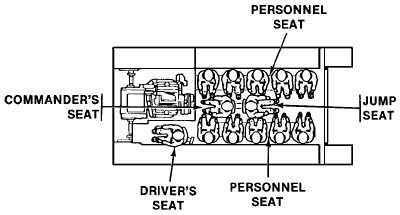
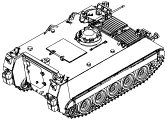
M113A3
850x610, 57K, GIF
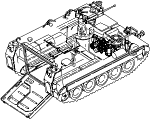
M113A3 cutaway view
940x740, 66K, GIF

M113A3 camo pattern
660x850, 68K, GIF

M113A3 camo pattern
675x835, 63K, GIF
- M58 Full Tracked Mechanized Smoke Obscurant Carrier
-
Smoke generator carrier. Used to provide large area multi spectral obscurant screening for maneuvering forces. Capable of producing 90 minutes of visual and 30 minutes of Infrared screens.
- M106 Self-propelled 107mm Mortar Carrier
-
This carrier is designed to carry the 4.2-inch (107mm) M30 mortar. The mortar
can be fired from a turntable in the carrier, or removed and fired from a ground baseplate.
- M125 Self-propelled 81mm Mortar Carrier
-
This carrier is designed to carry an 81mm mortar. The mortar can be fired from a turntable mounted in the carrier, or from a ground baseplate.
- M132 Full Tracked Self-propelled Flame Thrower
-
"Carrier, Flame Thrower, Self-Propelled". Carrier mounts a flame thrower weapon system.
During the Vietnam War these units were extremely useful when employed against dug-in Viet Cong positions, particularly when the positions were in dense thickets or scrub growth.
The flamethrowers were practicularly effective when employed in pairs and maintenance and logistical problems were minimal.
- M163 Self-propelled 20mm Air Defense Artillery Gun
-
 M741 carrier with a 20mm Vulcan air defense weapon system.
M741 carrier with a 20mm Vulcan air defense weapon system.
- M474 Tracked Carrier
-
Cargo version of the M113 APC. Carrier vehicle for the Pershing I system (replaced by a wheeled transporter).
- M548 6 Ton Tracked Cargo Carrier
-
An unarmored full-tracked transportation vehicle intended for use in forward areas.
- M577 Light Tracked Command Post Carrier
-
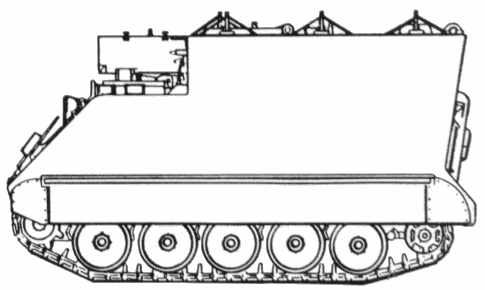 This is a lightweight carrier used as an operational staff office and command post. A tent extension attaches
to the rear of the carrier and doubles the available work area.
This is a lightweight carrier used as an operational staff office and command post. A tent extension attaches
to the rear of the carrier and doubles the available work area.
- M667 Missile Equipment Carrier
-
This is a lightweight, unarmored carrier used to transport weapons systems such as the Lance missile.
- M730 Guided Missile Equipment Carrier
-
A modification of the M548. The modified XM548E1 prototype system was redesignated as the XM730.
This unarmored carrier transports the M54-series Chaparral Aerial Intercept Guided Missile Subsystem.
- M741 20mm AAA Chassis
-
The carrier vehicle used by the M163 Vulcan weapon system.
- M752 Self-Propelled Launcher
-
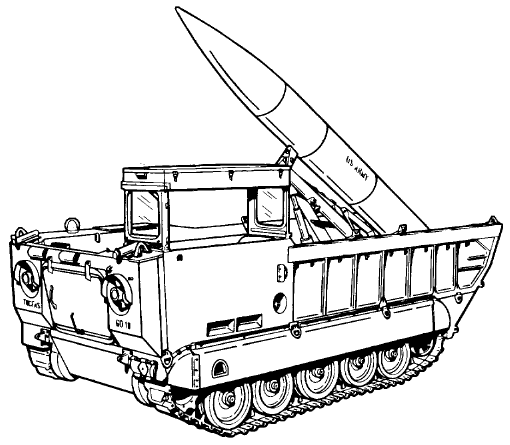 Consists of the M667 basic vehicle, a basic Lance launch fixture, and a warhead section support assembly. The
basic launch fixture is mounted in the cargo compartment of the basic vehicle and is capable of transporting a
completely assembled Lance guided missile, as well as all required equipment.
Consists of the M667 basic vehicle, a basic Lance launch fixture, and a warhead section support assembly. The
basic launch fixture is mounted in the cargo compartment of the basic vehicle and is capable of transporting a
completely assembled Lance guided missile, as well as all required equipment.
- M901 Improved TOW Vehicle
-
Carrier mounts a TOW launcher platform. Anti-tank vehicle.
- M981 FIST-V Carrier, M981 Fire Support Vehicle (FSV).
-
1986. Fire Support Team Vehicle. Used as an artillery forward observer vehicle.
- M1015 Tracked Electronic Warfare Carrier
-
A modified M548 tracked cargo carrier. Systems which use this carrier include:
- AN/MLQ-34 TACJAM.
A high-power, ground-based, communications jammer which generates three simultaneous, independent jamming signals.
It is housed in a ballistically protected shelter that is mounted on an M1015 electronic warfare systems carrier.
Several innovative features aid in the setup and teardown time of the system to include an onboard power generator, an automatic ground rod driver, and a 37-foot, quick-erect pneumatic antenna mast (Magic Mast).
These features permit transition from cross-country travel or convoy to full operation in less than 2 minutes.
Inside the shelter are three liquid-cooled transmitters, a control computer, receivers, operator interfaces, and communications equipment.
- AN/TSQ-114 Trailblazer.
A ground-based system that provides intercept and location of communications signals.
Each system consists of five stations; each station is housed in a ballistically protected shelter mounted on an M1015 vehicle that pulls a 30-kilowatt generator trailer.
Each station uses a 50-foot hydraulic, pneumatic quick-erect Magic Mast, receivers and computers.
The five stations are tied together with a data link; thus, very rapid determination of communications emitter locations is possible.
- M1059 Full Tracked Smoke Generator Carrier
-
This carrier is designed to generate a smoke screen in the battlefield environment using the M157 smoke generator set.
- M1064 Self-propelled 120-mm Mortar Carrier
-
This carrier is designed to carry the 4.7 inch (120mm) M121 mortar. The mortar can be fired from a turntable in the carrier, or removed and fired from a ground baseplate.
- M1068 Standard Integrated Command Post System Carrier
-
This carrier is designed as a command post and staff office. A modification of the M577A2 Command Post Carrier.
- Opposing Forces, Surrogate Vehicle (OSV) M113A3/BMP-2 (NSN 2350-01-420-4716)
-
1995. Also known as "Opposing Forces Surrogate Training Systems (OSTS) M113/BMP-2," or "M113/BMP-2 OSTS."
Carriers modified to visually portray BMP-2 Infantry Fighting Vehicles.
Will replace M551-based OPFOR vehicles used at the U.S. Army National Training Center at an estimated cost of $300,000 per vehicle.
Excess M901 chassis will be upgraded to M113A3 chassis standards which will then be modified to include the addition of a turret and related visual modifications.
The two-man turret will include an M2A2 Bradley Fighting Vehicle (BFV) turret drive system and stabilization system, various subassemblies, and both visual and Tactical Engagement Simulation (TES) representation of the BMP-2 onboard weapon systems.
The vehicle will be operated by a three-man crew and the extended rear compartment will accommodate up to five infantry soldiers and their equipment (a capability not supported by the M551/BMP).
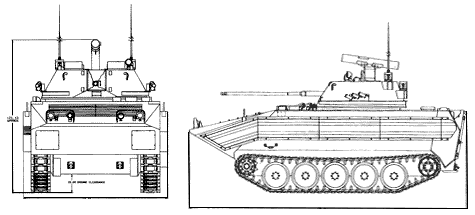
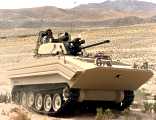
M113A3/BMP-2
11th Advanced Cavalry Regiment at National Training Support Center
23-JUL-1998
U.S. DoD Photo by Jeff Mellody
1024x681, 255K, JPEG
- SLUFAE
-
Surface Launched Unit, Fuel Air Explosive. A 30-tube armored rocket launcher mounted on an M548 carrier.
Designed to clear paths through mine fields using the overpressure created by exploding liquid chemical aerosol clouds.
A joint U.S. Army-Navy research project.
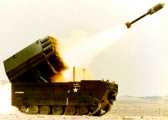
SLUFAE prototype
U.S. Army Photo
720x576, 34K, JPEG
- XM546 Guided Missile Carrier
-
A modified version of the M113 APC lengthened to transport the Mauler guided missile air defense weapon system.
Creation of formal requirements for the Mauler began in 1956. Mauler development program started in 1960 with the Convair Division of General Dynamics as the prime contractor.
The prototype XM546 vehicle and D-2 Mauler weapon pod, tested in 1961, were designed and built by the Food Machinery & Chemical Corporation (FMC).
A proposed XM546E1 carrier would have added a sixth pair of roadwheels to deal with overloading and weight distribution problems.
Lack of financial support and unsolved technical problems led to cancellation of the Mauler in 1965.
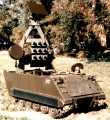
Mauler prototype, 1964
U.S. Army Photo
720x576, 100K, JPEG
- XM806E1 Light Armored Recovery Vehicle
-
"Recovery Vehicle, Full-Tracked, Light Armored (M113A1) XM806E1."
The XM806E1 recovery vehicle is an M113A1 APC modified for recovery of disabled vehicles comparable in weight to the M113A1.
The vehicle was scheduled for operation at Aberdeen Proving Ground for 4,000 vehicle test miles, of which 1,000 were with an M113A1 in tow.
Also, 100 winch operating hours and 12 crane operating hours were conducted.
Testing was under actual field conditions on missions which typify normal operational use of the equipment by troops in the field.
The maintenance ratio for the test vehicle was 0.0815 hour of active maintenance time per mile of vehicle operation.
Based on 4,001.2 miles of operation and 17 equipment failures, the MTBF was 235.3 miles.
The total active maintenance time to repair failures was 133.2 man-hours and 46.5 clock-hours giving a MTTR of 7.78 man-hours and 2.73 clock-hours.
More than 100 variants have been produced in numerous countries, with 7.62mm MGs, 40mm automatic grenade launchers,
90mm recoilless rifles, and turrets with 20-to-76mm cannons.
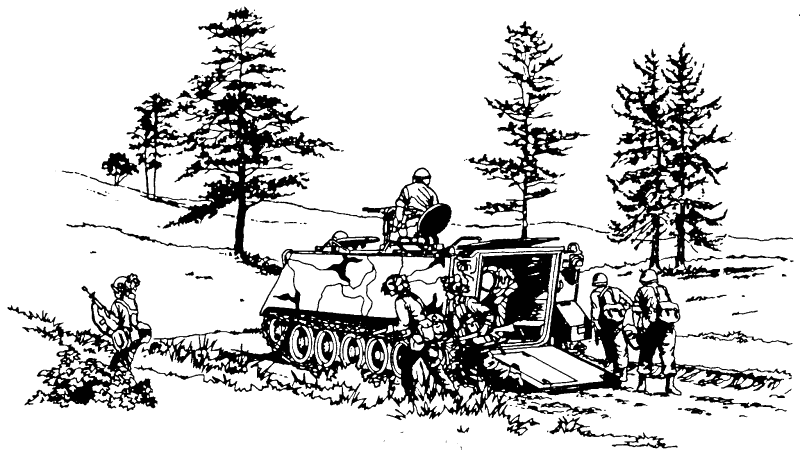

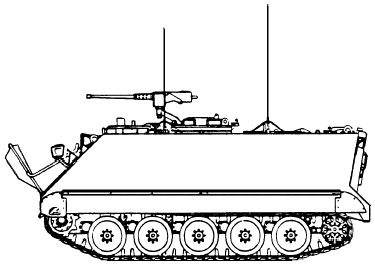
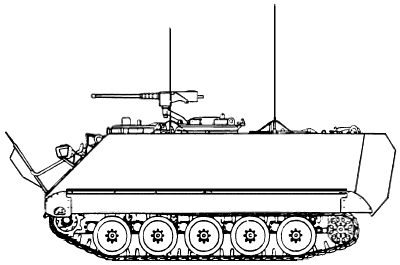

 M741 carrier with a 20mm Vulcan air defense weapon system.
M741 carrier with a 20mm Vulcan air defense weapon system.
 This is a lightweight carrier used as an operational staff office and command post. A tent extension attaches
to the rear of the carrier and doubles the available work area.
This is a lightweight carrier used as an operational staff office and command post. A tent extension attaches
to the rear of the carrier and doubles the available work area.
 Consists of the M667 basic vehicle, a basic Lance launch fixture, and a warhead section support assembly. The
basic launch fixture is mounted in the cargo compartment of the basic vehicle and is capable of transporting a
completely assembled Lance guided missile, as well as all required equipment.
Consists of the M667 basic vehicle, a basic Lance launch fixture, and a warhead section support assembly. The
basic launch fixture is mounted in the cargo compartment of the basic vehicle and is capable of transporting a
completely assembled Lance guided missile, as well as all required equipment.

